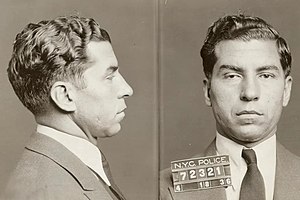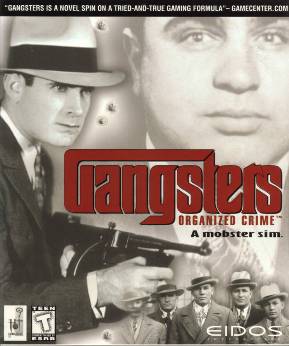by Elizabeth Hall
Introduction
Almost everyone has heard of the movies and television shows depicting the mafia and organized
| Cover of The Godfather (Widescreen Edition) |
crime in the United States including, The Sopranos, Goodfellas, The Godfather Trilogy, etc and has seen with this the romanticism of a large segment of criminals operating in our nation. Most of us do not think about the reality that these characters are based on a real criminal enterprise that has been in operation since the early years of our country and the corruption there. Organized crime is alive and well in our society, and in order to understand the influence that this criminal enterprise has had on our nation we must analyze the past to understand the future. In this essay, we will explore and analyze the real history of the origins and influence of organized crime in America including the foundations of organized crime,
attributes, definitions and the structure and influences between it and our government.
Foundations of Organized Crime
| Mugshot of Charles Luciano at 1936,Italian-American mobster (Photo credit: Wikipedia) |
According to Abadinsky (2009), the beginnings of organized crime began with the knit of growing “machine politics” and the influx of society reacting to prohibition. It allowed Jewish, Irish, and Italian immigrants to the country the perfect opportunity to achieve social mobility through the manufacture, distribution, and retailing of alcohol in a time when people wanted it and it was illegal to manufacture, distribute and sell, however not illegal to use. This came along after the Robber Barons, named for their ruthless business practices when it came to acquiring their wealth. These men, Astor, Rockefeller, Vanderbilt, and Carnegie to name a few, took full advantage of the rise of unchecked capitalism in this country, and made their fortunes off the many (Abadinsky 2009).
| Gangsters: Organized Crime (Photo credit: Wikipedia) |
Most of these family names are still in power today, albeit with more legitimate practices in their enterprises; however, this country’s business practices still border on the edge of criminal with the amount of corporate fraud and corrupt businesses that we see on the news almost weekly (Abadinsky, 2009). As businesses grew into monopolies, the Robber Barons left little room for the immigrants to move upward into social mobility living in slums and tenements. The only thing that they had worth value was their votes, and in came the political machines. The Irish immigrants were the labor that worked to make the cities run, and the politicians used this to their full advantage during the 1800’s most notably with Tammany Hall and the Tweed Ring. As noted by Abadinsky (2009), even those voters not participating in the illegal activity had the full realization that not cooperating with the machine would mean the denial of basic services for them and trouble surviving.
This gradual action, paved the way for the next generation to move in and take over in the organized crime spots by Irish, Jewish, and Italian immigrants particularly during the era of Prohibition (Abadinsky, 2009). As the National Archives (n.d.) state, by the beginning of the 20th century the temperance movement was in full swing with Protestants in the lead. This was essentially the White Protestants against the Irish, Catholics, and Jews. During prohibition, because of the setup of public corruption already in place, the Irish found it easy to move up the social mobility ladder during this time because they already had the bonds and relationships in place to draw on the strengths they learned when battling the British government in Ireland.
| Al Capone. Mugshot information from Science and Society Picture Gallery: Al Capone (1899-1947), American gangster, 17 June 1931. 'Al Capone sent to prison. This picture shows the Bertillon photographs of Capone made by the US Dept of Justice. His rogue's gallery number is C 28169'. (Photo credit: Wikipedia) |
Later as more immigrants of Jewish and Italian descent came to the United States they found themselves in the same position as the Irish, and followed suit through ethnic succession finding the same easy path to social mobility through the speakeasies of the times (Abadinsky, 2009). Before Prohibition passes, the Italian tribute to American Organized Crime La Costra Nostra forms, appointing 25 families in the United States intended
to act as a national crime syndicate notes O’Connor (2012). These families fall under the leadership of five particular families, Gambino, Lucchese, Columbo, Bonnano and Genovese who came together through the Black Hand gang and Johnny Torrio, who led the Five Points Gang. At this time, this was the Italian Mafia’s way of separation from the Sicilian Mafia as they were longtime enemies. Through this act, they averted violence between the groups and gained more financial mobility, thereby making their profit margins larger by operating peacefully with one another (O’Connor, 2012).
| English: Structure about Organized Crime Central Area from Police of the Generalitat - Mossos d'Esquadra. Català: Organigrama de l'Àrea Central de Crim Organitzat de la Policia de la Generalitat - Mossos d'Esquadra. (Photo credit: Wikipedia) |
Defining Attributes and Definitions on Organized Crime
According to the Federal Bureau of Investigation (FBI), (n.d.) organized crime is defined as any group of people operating under an organized structure with the sole purpose of the group and structure being to make profit through criminal activity. Organized crime has many definitions and as reported by Abadinsky (2009) and O’Connor (2012) they could be addressing any one or combination of six different types of crimes. These are; crimes executed as a business such as white collar and corruption crimes, counterfeiting and cultural property theft, contraband and narcotics, human trafficking, contract killing, and computer crime. Both Abadinsky (2009) and O’Connor (2012), hold that the definitions of organized crime are many, however they do agree that there are several distinct attributed that distinguish organized crime from other types of crime. O’Connor (2012) lists them as;
“Lack of political goals, hierarchical structure, limited or exclusive membership, constitution as a unique subculture, self-perpetuation, willingness to use illegal violence and bribery, demonstrated specialization/division of labor”, and finally “monopolism, and governance by explicit rules and regulations”.
It is these attributes, which allow us to distinguish between organized crime and other types of crime. Abadinsky (2009) explains this well by comparing Jesse James and Al Capone, as the organization surrounding the James gang did not withstand his death in 1882, while the Capone organization went on like nothing ever happened.
Gaining Ground in the United States
Abadinsky (2009) discusses the fact that since the beginnings of industry in the United States we have always been a violent nation, and that because of the robber barons, the strain of anomie can account for the reasons that organized crime came about in this country through the channels that our immigrants learned in their home countries. He also makes the point that for the most part corrupt business practices are alive and well even today in the United States. That said, organized crime is also alive and well in this country, and for the same reasons, and these days gaining ground within. Bjelopera & Finklea (2012) report that it is the increased technological capabilities of cellular phones and the internet that allow these groups to operate in much looser organizational structures than those used by the Italians that make it easier for them to operate and harder for law enforcement to monitor and catch. This along with the increased use of utilizing other groups or persons to perform certain tasks instead of keeping all aspects of the criminal activity within their own criminal organization allows them to gain ground faster than ever before (Bjelopera & Finklea, 2012).
Organized Crime and Governmental Influence
| BC-Washington Organized Crime Forum (Photo credit: BC Gov Photos) |
Since the days of Tammany Hall and Boss Tweed, the corrupt aspects of government have utilized organized crime to follow the example of the robber barons to influence what happens in government. Abadinsky (2009) notes that several committees and commissions including the Kefauver Crime Committee, the McClellan Committee, President’s Commission on Law Enforcement, and the President’s Commission on Organized Crime have formed to deal with this growing problem over the decades helping to resolve the organized crime problem.
According to the United States Attorney Manual (USAM) (n.d.) in 1970 in an attempt to curb this activity, the Organized Crime Act passed, giving law enforcement a tool they could work with. Title IX of this act is entitled Racketeer Influenced Corrupt Organizations Statute (RICO) and the sole purpose of this portion is to stop the insertion of organized crime into legitimate business enterprises, particularly those that participate in interstate business transactions. While RICO does have some issues, this has been the most effective tool so far (USAM, n.d.).
| Organized Crime Agency of British Columbia (Photo credit: Wikipedia) |
Organized Crime Structure after Prohibition
There are two organizational structures that fit with organized crime, particularly after Prohibition came and went; these are the bureaucratic or corporate structure and the patron-client network. Every organized crime group works under one of these models, and Abadinsky (2009) explains the distinction by type of group. For example, the Italian mafia operates under the client-patron model with their favor and family style organization; whereas the Hell’s Angels and their kind use the bureaucratic/corporate structure. Even though the structures become looser as technology advances, and criminals utilize technology to keep their structures hidden, the basic models are the same.
Conclusion
In the examination of the history, attributes, definitions, and structure of organized crime in the United States it is easy to see why this has become such a problem for this country and at the same time an integral part of our history. As the poor in our country feel the strain of anomie while the corrupt business practices continue by the new age of robber barons, namely big business corporations the poor utilize whatever means they can to achieve upward mobility in society. Although the decades change and there are more laws in place to curb this activity the corruption in business remains the same as the original robber baron families continue to control the economic status and intermarry to keep that control. It seems that the only way to solve this problem is to do what should have been done decades ago, and control the corruption in big business.
References
Abadinsky, H. (2009). Organized crime (9th ed.). Belmont, CA: Wadsworth, Cengage Learning
ISBN: 0-495-59966-2
ISBN: 0-495-59966-2
Bjelopera, J.P. & Finklea, K.M. (2012). Organized Crime: An Evolving Challenge for Law Enforcement. Congressional Research Service. Retrieved From: http://www.fas.org/sgp/crs/misc/R41547.pdf
Federal Bureau of Investigation (FBI), (n.d.). Organized Crime: Glossary. Retreived From: http://www2.fbi.gov/hq/cid/orgcrime/glossary.htm
O’Connor, T., (2012). Organized Crime Investigation. Class Lecture Notes Megalinks in Criminal Justice Retrieved From: http://www.drtomoconnor.com/3220/3220lect07a.htm
United States Attorney’s Manual (USAM) (n.d.). USAM Chapter 9-110.000: Organized Crime and Racketeering. Retrieved From: http://www.justice.gov/usao/eousa/foia_reading_room/usam/title9/110mcrm.htm
United States National Archive and Record Association (National Archive), (n.d.). Teaching with Documents: The Volstead Act and Related Prohibition Documents. Retrieved From: http://www.archives.gov/education/lessons/volstead-act/























0 comments:
Post a Comment